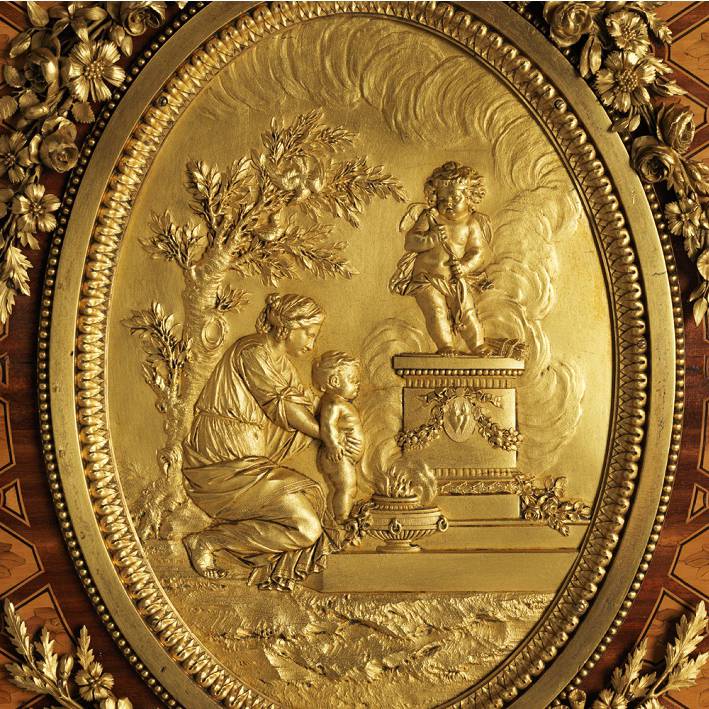MEET THE EXPERT: FIVE SEVRES COLOURS AT THE WALLACE COLLECTION
In addition to refined shapes, the porcelain manufactory of Sèvres, originally situated in Vincennes, produced an iconic colour palette that set its wares apart from contemporary production in France. Artists at the manufactory worked alongside chemists who excelled in producing a range of ground colours that, combined with delicately painted motifs in the milky-white reserves and an extensive use of gilding, created striking pieces.
Amongst the variety of ground colours produced by the manufactory, the best represented in the Wallace Collection are:
BLEU LAPIS
The intense blue that covers the ground of this sugar bowl is known as 'bleu lapis', a reference to the semi-precious stone lapis lazuli. Introduced in 1752, this is the first ground colour produced at the Manufacture de Vincennes. From the late Middle Ages Europeans paid enormous prices for the lapis-lazuli employed to produce ultramarine pigment for its use in paintings. However, in ceramics deep blue is obtained by applying the much cheaper cobalt on the unglazed chalky body of the pot. The pieces were covered with a transparent glaze and then fired. The mottled effect is similar to that on Chinese ‘bleu soufflé’ or ‘blown blue’ pieces, a technique obtained by blowing powdered cobalt on the unglazed pots through a gauze. This sugar pot is profusely gilded, some of it cleverly covering the uneven blue edges of the white reserves.
BLEU CELESTE
The luminous turquoise blue of this flower vase creates a dazzling effect in combination with the white reserves and gilding. Known as ‘bleu céleste’, it forms part of a number of ground colours developed during the 1750s by the manufactory’s head chemist, Jean Hellot, a member of the Académie Royale des Sciences. This ground colour was first introduced in 1753 on a richly decorated dinner service for Louis XV, and it was notoriously expensive to produce. The powdered pigment, a mixture of copper and cobalt, was carefully sprinkled onto the unfired glaze to which a sticky undercoat had been added. Its name may be either an homage to China, the ‘Empire Céleste’, from where porcelain had been imported in great quantities into Europe, or a reference to the sky-blue sash worn by the knights of the French chivalry order of the Saint-Esprit awarded by the king.
FOND VERT
Preparing the pigments for the ground-colour decoration applied to Sèvres porcelain was a complicated process. It required numerous stages of grinding, boiling and washing before obtaining the final powdered mixture that was added to the pieces. The introduction of green roughly coincides with the transfer of the manufactory from Vincennes to Sèvres in 1756. The records speak of a succession of recipes by the team of factory chemists before the perfect green was achieved. From the blueish greens of 1757 to the more yellow ‘apple’-green of the 1770s, all greens were copper based. The beautifully even and bright green used to decorate this bulb pot has been cleverly applied in a lattice pattern with gold outlines that creates the illusion of depth and is reminiscent of a trellis or garden setting. Green and pink were often combined in this way, a dazzling juxtaposition of complementary colours.
FOND ROSE
In the early 1750s Vincennes produced porcelain decorated with a reddish colour that varied from carmine to purple, however these pieces pale in comparison to the striking effect of later pieces decorated with a pink ground. Known as ‘fond rose’, it was first recorded at Sèvres in 1758, the year this jug and basin were created. Pink ground colour attained huge success and quickly became one of the most iconic colours of the Sèvres palette, even though its production declined in the late 1760s. Sophisticated rococo motifs in gilding cover the surfaces of our jug and basin. Those applied over the pink ground have fine lines of carmine enamel edging, a technique believed to prevent the discolouring of the pink ground in contact with the gilding. Visually, those darker accents give depth to the intricate decoration.
BLEU NOUVEAU or BEAU BLEU
In 1763, an improved version of the original ‘bleu lapis’ ground colour was introduced at Sèvres: the ‘bleu nouveau’. As opposed to the mottled effect of the former, the new deep blue was even and consistent, qualities that earned it the appellation ‘beau bleu’, beautiful blue, from 1768. To obtain such a uniform effect, three layers of cobalt-based enamel were applied over the glaze with a thick brush. The resulting deep royal blue was perfectly suitable to decorate the new pieces created in the goût grec, or Grecian taste, a neoclassical style in vogue during the 1760s. An imposing example, this vase is quintessentially neoclassical, with its decoration derived from Greek and Roman architecture. The alternating solid areas of blue, white and gold, create an elegant rhythm characteristic of this fashion.








